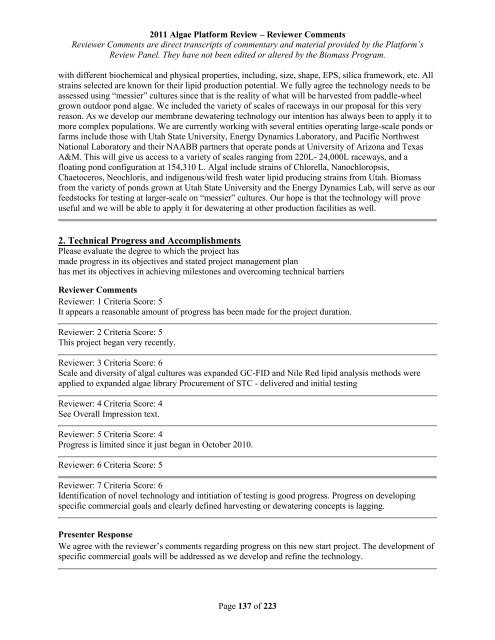Reviewer Comments - EERE
Reviewer Comments - EERE
Reviewer Comments - EERE
You also want an ePaper? Increase the reach of your titles
YUMPU automatically turns print PDFs into web optimized ePapers that Google loves.
2011 Algae Platform Review – <strong>Reviewer</strong> <strong>Comments</strong><br />
<strong>Reviewer</strong> <strong>Comments</strong> are direct transcripts of commentary and material provided by the Platform’s<br />
Review Panel. They have not been edited or altered by the Biomass Program.<br />
with different biochemical and physical properties, including, size, shape, EPS, silica framework, etc. All<br />
strains selected are known for their lipid production potential. We fully agree the technology needs to be<br />
assessed using “messier” cultures since that is the reality of what will be harvested from paddle-wheel<br />
grown outdoor pond algae. We included the variety of scales of raceways in our proposal for this very<br />
reason. As we develop our membrane dewatering technology our intention has always been to apply it to<br />
more complex populations. We are currently working with several entities operating large-scale ponds or<br />
farms include those with Utah State University, Energy Dynamics Laboratory, and Pacific Northwest<br />
National Laboratory and their NAABB partners that operate ponds at University of Arizona and Texas<br />
A&M. This will give us access to a variety of scales ranging from 220L- 24,000L raceways, and a<br />
floating pond configuration at 154,310 L. Algal include strains of Chlorella, Nanochloropsis,<br />
Chaetoceros, Neochloris, and indigenous/wild fresh water lipid producing strains from Utah. Biomass<br />
from the variety of ponds grown at Utah State University and the Energy Dynamics Lab, will serve as our<br />
feedstocks for testing at larger-scale on “messier” cultures. Our hope is that the technology will prove<br />
useful and we will be able to apply it for dewatering at other production facilities as well.<br />
2. Technical Progress and Accomplishments<br />
Please evaluate the degree to which the project has<br />
made progress in its objectives and stated project management plan<br />
has met its objectives in achieving milestones and overcoming technical barriers<br />
<strong>Reviewer</strong> <strong>Comments</strong><br />
<strong>Reviewer</strong>: 1 Criteria Score: 5<br />
It appears a reasonable amount of progress has been made for the project duration.<br />
<strong>Reviewer</strong>: 2 Criteria Score: 5<br />
This project began very recently.<br />
<strong>Reviewer</strong>: 3 Criteria Score: 6<br />
Scale and diversity of algal cultures was expanded GC-FID and Nile Red lipid analysis methods were<br />
applied to expanded algae library Procurement of STC - delivered and initial testing<br />
<strong>Reviewer</strong>: 4 Criteria Score: 4<br />
See Overall Impression text.<br />
<strong>Reviewer</strong>: 5 Criteria Score: 4<br />
Progress is limited since it just began in October 2010.<br />
<strong>Reviewer</strong>: 6 Criteria Score: 5<br />
<strong>Reviewer</strong>: 7 Criteria Score: 6<br />
Identification of novel technology and intitiation of testing is good progress. Progress on developing<br />
specific commercial goals and clearly defined harvesting or dewatering concepts is lagging.<br />
Presenter Response<br />
We agree with the reviewer’s comments regarding progress on this new start project. The development of<br />
specific commercial goals will be addressed as we develop and refine the technology.<br />
Page 137 of 223




